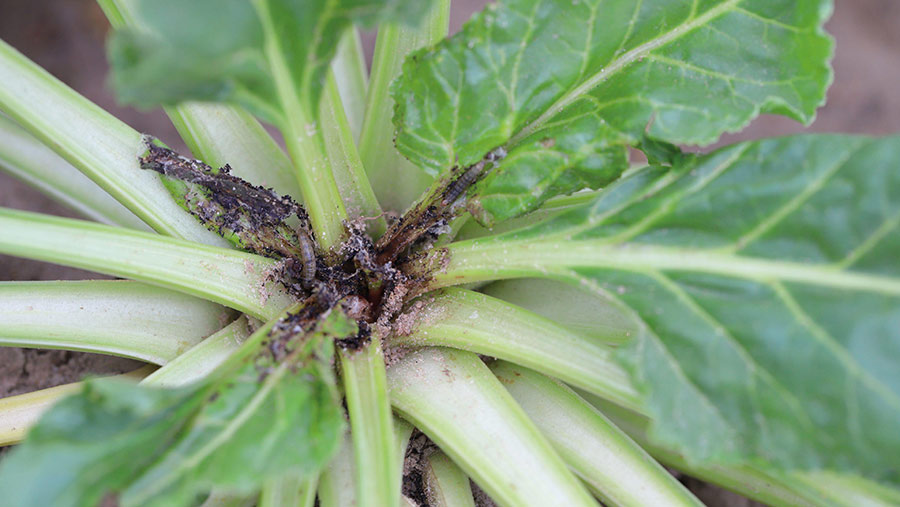The rare moth putting sugar beet yields at risk this autumn
 © Tomasz Klejdysz/Alamy Stock Photo
© Tomasz Klejdysz/Alamy Stock Photo There are reports of an uncommon moth larvae infecting sugar beet crops across the east of England, raising fears of significant yield penalties as harvest nears.
Experts from the British Beet Research Organisation (BBRO) are advising growers to closely monitor crops for symptoms of the beet moth, which include blackening of the crown and the loss of new leaves.
They are also urging farmers with infected crops to review their planned harvest dates and consider lifting crops early to avoid further reductions in yield and quality.
See also: Crop Watch: Late-drilled OSR battles beetles, cereals under way
What is the pest?
A rare pest in the UK, the beet moth (Scrobipalpa ocellatella) is frequently found in mainland Europe, where it is associated with warmer and drier climates.
This summer’s hot temperatures, coupled with a dry and warm autumn, is thought to have favoured the moth’s spread and development, triggering its first attack on UK beet crops.
The pest has become more widespread since its initial reports in Suffolk and Norfolk.
One grower whose crops is significantly affected is Suffolk farm manager Edward Vipond, who first identified early symptoms of the pest back in July.
“This is the first time we have ever experienced anything like this. Every plant is affected by the larvae to some extent.
“We have almost no new leaf growth as emerging leaves are eaten or badly deformed. The issue is certainly not getting any better,” he says.

Edward Vipond © Jason Bye
The symptoms are easily confused with boron deficiency, with blackening of the crown. It wasn’t until he did a closer inspection that Mr Vipond discovered a number of caterpillars causing significant leaf damage.
With no means of controlling the pest, he suspects 80% of his 130ha beet crop, which is spread over 20 miles, is now infected, causing real concern as harvest looms closer.
It is thought that continued warm, dry autumn conditions will favour the moth’s development into early October, causing further damage to crops and potential secondary pathogen infections.
No solution
Mr Vipond is not only concerned about the yield reduction from the loss of green area, but also potential taproot damage, which may lead to rotting and further yield and quality losses.
“The real issue is that we do not have a solution to the problem. The only way is irrigation to wash the caterpillars off the crop, but we don’t know how effective this would be.”
With the Bury St Edmunds sugar beet factory scheduled to open on 7 October, Mr Vipond plans to start harvest in the middle of the month.
He is aiming to lift a bigger proportion of sugar beet earlier in the season in a bid to overcome the moth infestation and avoid further losses.
But he admits this will mean missing out on the usual extended growing period and additional yield-building phase later-lifted crops get.
Advice from the BBRO on how to control the pest
- Wet and cold weather with heavy rain showers is thought to help deter the pest’s development
- It is likely that in the absence of a cold winter, adults will be able to survive and migrate into spring crops, where they will breed and lay their eggs, before the cycle begins again
- There is potential for a foliar insecticide spray, but pyrethroids are variable and can negatively affect beneficial insect populations. What’s more, it is difficult to directly target the larvae that lie within the heart leaves
- There are a few products, such as Cythrin, available that can provide general caterpillar control, but following label recommendations is vital
- Keeping all remaining and future leaves as green and healthy as possible will help mitigate the effect of beet moth damage, highlighting the importance of a robust disease programme
- Ploughing down beet remnants infected by beet moth could help to decrease the risk for 2023
Extent of damage
The extent of damage will depend on the number of larvae present and, in many cases, plants will continue to produce new leaves.
However, where damage is more severe, the affected crown may be killed and lateral growing points stimulated to produce leaves, resulting in multi-crowning.
As the damage progresses, it is possible to find a second generation establishing in crops, with numerous moths flying around the canopy.
This can cause further damage to the heart as well as the surface layer of the taproot, resulting in infection by secondary pathogens and further deterioration of the taproot leading to localised rotting.
It is possible for the plant to recover from damaged heart leaves by forming multiple crowns around the centre.
However, this risks the formation of a hollow crown, which could lead to further taproot damage from water settling or frost.
Source: BBRO

